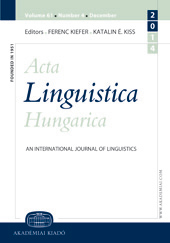Zsigmond Simonyi (1853–1919)
Zsigmond Simonyi (1853–1919)
Author(s): László HontiSubject(s): Historical Linguistics, Finno-Ugrian studies
Published by: Akadémiai Kiadó
Keywords: historiography; historical linguistics; Hungarian linguistics; Finno-Ugric linguistics; linguistic contacts;
Summary/Abstract: Zsigmond Simonyi was the most influential Hungarian linguist of the turn of the 19th and 20th centuries. He acquired wide and deep professional knowledge at various universities in Hungary and abroad. His work was influenced by Neogrammarian ideas but his attitude to them was also critical to the necessary extent. This is demonstrated by the fact that he studied the contacts between Hungarian and the languages spoken in neighbouring countries in the wake of Schuchardt’s ideas. He was a Neogrammarian by education, but his views on historical linguistics were more modern, more akin to those of the younger generation of Neogrammarians. Thus, unlike most representatives of the classical Neogrammarian school, he did not restrict his attention to the phonological aspects of language change. Rather, he also studied larger units like phrases or sentences, as well as semantics. He attached special importance to discussing phenomena of the current spoken language, especially those of the various dialects, to keep track of linguistic facts as evidence for changes that have taken place. The enormous “Historical dictionary of Hungarian” that he co-authored with Gábor Szarvas has retained its value as a source of information to the present day, and continues to be an indispensable tool in research on etymology and historical linguistics.
Journal: Acta Linguistica Hungarica (Since 2017 Acta Linguistica Academica)
- Issue Year: 55/2008
- Issue No: 1-2
- Page Range: 59-79
- Page Count: 21
- Language: English

